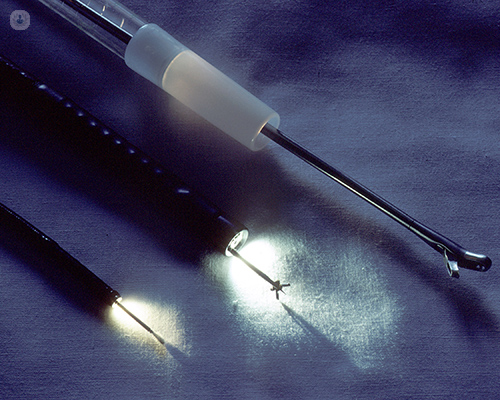What is an endoscopic ultrasound and why do I need one?
Written by:Endoscopic ultrasound is a procedure which allows a doctor to examine structures beyond the wall of the upper digestive tract, such as the pancreas, to find abnormalities, take tissue samples, and sometimes to drain infections. Dr Gavin Johnson, an expert gastroenterologist and interventional endoscopist, explains more about the procedure, and what you can expect on the day.

What is an endoscopic ultrasound?
An endoscopic ultrasound, sometimes referred to as an echo-endoscopy, or EUS, is a procedure in which an endoscope, a long telescope which examines the inside of the body, with a tiny ultrasound probe on the end of it is inserted through the mouth into the oesophagus, stomach and duodenum (the top of the small intestine). The probe emits sound waves and the console forms an image on a screen from the echo waves, which is possible because the sound waves echo in different ways off different tissues and structures.
The procedure itself is exactly the same as that of a regular endoscopy, with the differences being that a special type of endoscope is used and that the procedure often lasts rather longer.
Why do I need an endoscopic ultrasound?
Endoscopic ultrasound is most commonly used by gastroenterologists to obtain good views of lymph nodes, the pancreas, the liver, bile duct and gallbladder. Endoscopic ultrasound can be used to:
- Take a closer or better look at tumours/growths/abnormalities in organs such as the liver and gallbladder, and in the lymph nodes in the chest
- Give detailed staging of pancreatic cancers to determine if an operation is possible
- Investigate and evaluate chronic pancreatitis
- Look for tiny gallstones that have not been seen on other imaging techniques
- Evaluate other pancreatic disorders
- Investigate and study nodules (lumps) in the wall of the digestive tract
- Take a biopsy from lymph nodes, pancreas, liver and digestive tract lumps
- Drain cysts or infections in the pancreas
- Help to guide the specialist in the removal of small tumours
Endoscopic ultrasound can also be used together with ERCP (endoscopic retrograde cholangiopancreatography) for the location of gall stones which have moved into the bile duct and created an obstruction.
How is an endoscopic ultrasound performed?
The procedure must be performed on an empty stomach, and, aside from regular medication, no food or drink is allowed for at least six hours before the EUS.
Before undergoing an EUS, the patient is sedated, or given a full anaesthetic, and rested on their left side. Pulse and other vital signs are monitored throughout the procedure, and oxygen will be piped in through the nose. Saliva is removed through a suction tube whenever necessary. The endoscope is passed down through the mouth, but it is not painful and does not obstruct breathing.
The endoscopist examines the necessary organs and areas they wish to investigate, and if necessary, a biopsy (tissue sample), is taken. The procedure can last between 15 and 60 minutes depending on how complex it is, and whether a biopsy is taken or not.
After the procedure, the throat may feel a little sore, and some discomfort may be felt in the stomach if any air is left there. After the patient has rested, they are able to leave, but should arrange for someone to pick them up from the clinic.
Results can be given after the test from the endoscopist or specialist performing the procedure. If a biopsy was taken, results are available a few days later.
What are the risks of EUS?
Risks of the endoscopic ultrasound procedure are minimal, and rarely do any complications happen. However, as with any medical procedure, there are risks to consider, including:
- Bleeding (which is very rarely severe)
- Infection
- Making a hole in the oesophagus, stomach, or duodenum
- Reaction to sedative
- Discomfort and bloating
- Pancreatitis (usually mild form), if a needle has been passed into the pancreas
EUS, however, is considered to be a very safe procedure. Endoscopists are experts in the procedure and are extensively trained in order to prevent complications from occurring – and to be able to deal with them should they arise. Always make sure to ask any questions you might have about the procedure and its risks beforehand, so your mind can be put at rest.



